The Use of Kanban and its Effectiveness in Manufacturing Processes
VerifiedAdded on 2023/01/13
|6
|1307
|43
Report
AI Summary
This report delves into the application of the Kanban system within operations management, specifically examining its core elements and effectiveness, using Toyota as a case study. The main body identifies and discusses key elements of the Kanban process, such as limiting work in progress and continuous improvement, which are crucial for efficient production. It then analyzes how the Kanban system enhances manufacturing processes within an organization, highlighting cost-cutting through waste elimination, and the integration of just-in-time and Jidoka principles. The report emphasizes Toyota's approach to worker empowerment and safety, illustrating how these factors contribute to overall production efficiency and quality. The conclusion summarizes the importance of operations management and the benefits of the Kanban system in boosting production, ensuring quality, and streamlining processes through the integration of just-in-time and Jidoka methodologies.

THE USE OF JUST-
IN-TIME AND
TOTAL QUALITY
MANAGEMENT
PRINCIPLES
IN-TIME AND
TOTAL QUALITY
MANAGEMENT
PRINCIPLES
Paraphrase This Document
Need a fresh take? Get an instant paraphrase of this document with our AI Paraphraser
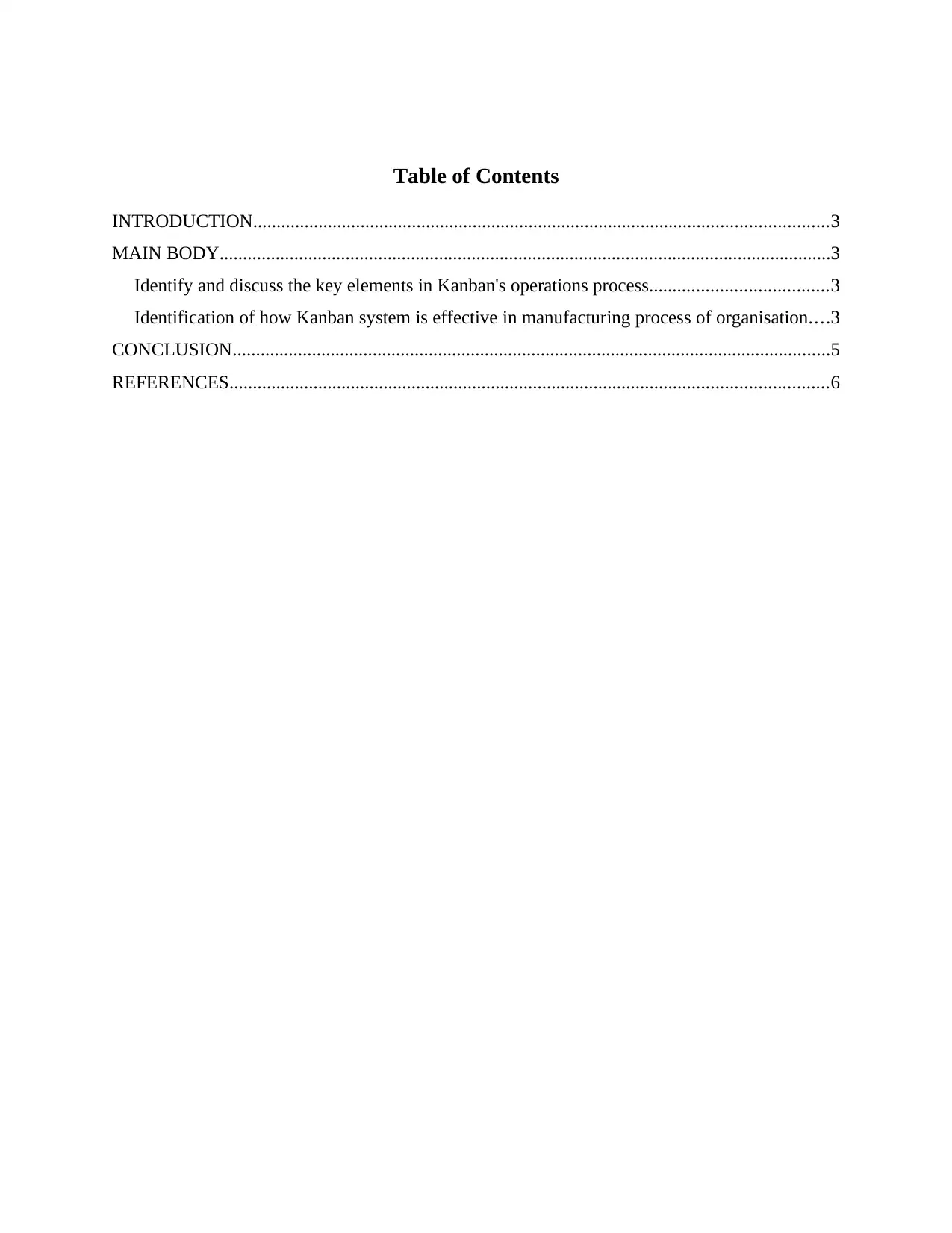
Table of Contents
INTRODUCTION...........................................................................................................................3
MAIN BODY...................................................................................................................................3
Identify and discuss the key elements in Kanban's operations process......................................3
Identification of how Kanban system is effective in manufacturing process of organisation....3
CONCLUSION................................................................................................................................5
REFERENCES................................................................................................................................6
INTRODUCTION...........................................................................................................................3
MAIN BODY...................................................................................................................................3
Identify and discuss the key elements in Kanban's operations process......................................3
Identification of how Kanban system is effective in manufacturing process of organisation....3
CONCLUSION................................................................................................................................5
REFERENCES................................................................................................................................6
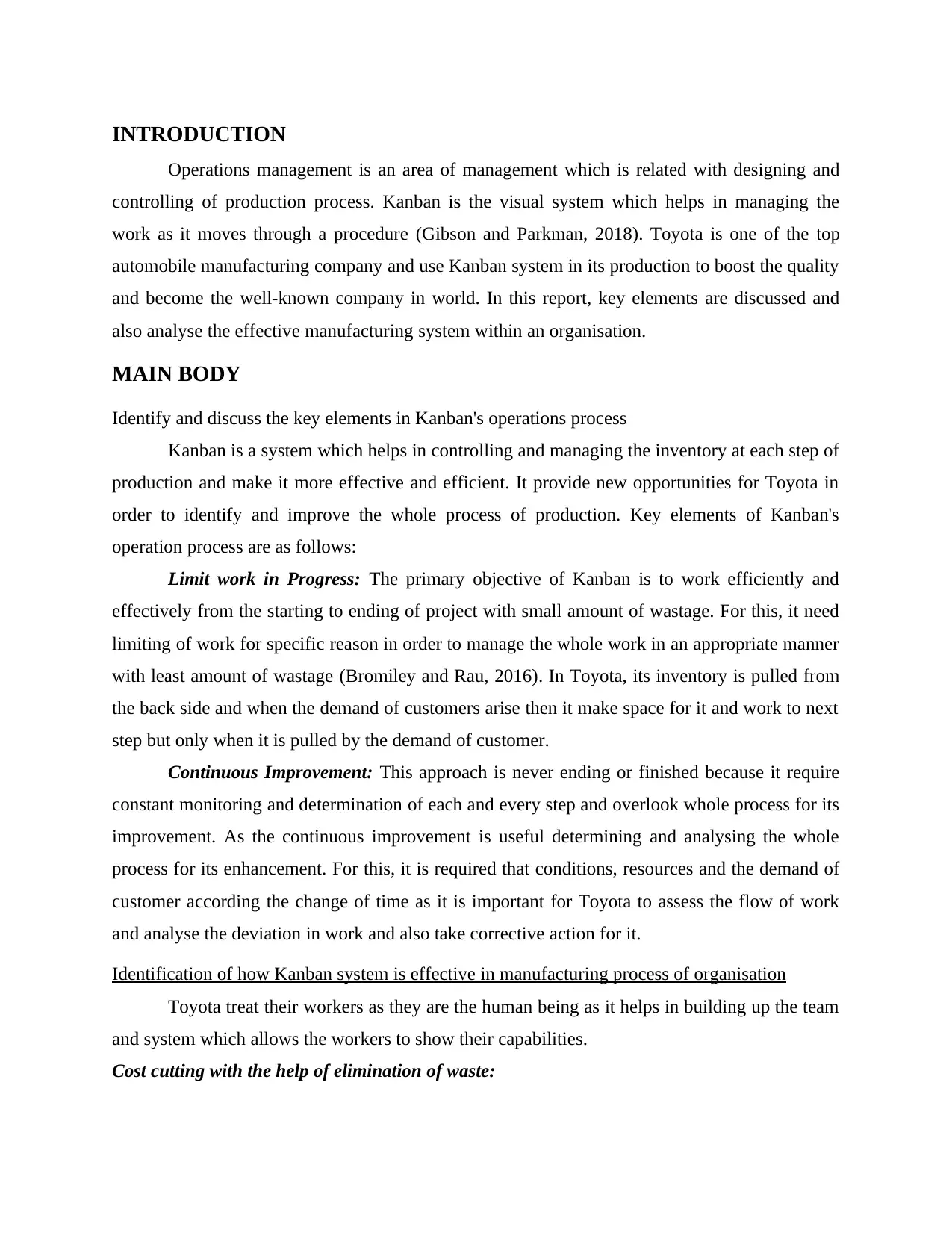
INTRODUCTION
Operations management is an area of management which is related with designing and
controlling of production process. Kanban is the visual system which helps in managing the
work as it moves through a procedure (Gibson and Parkman, 2018). Toyota is one of the top
automobile manufacturing company and use Kanban system in its production to boost the quality
and become the well-known company in world. In this report, key elements are discussed and
also analyse the effective manufacturing system within an organisation.
MAIN BODY
Identify and discuss the key elements in Kanban's operations process
Kanban is a system which helps in controlling and managing the inventory at each step of
production and make it more effective and efficient. It provide new opportunities for Toyota in
order to identify and improve the whole process of production. Key elements of Kanban's
operation process are as follows:
Limit work in Progress: The primary objective of Kanban is to work efficiently and
effectively from the starting to ending of project with small amount of wastage. For this, it need
limiting of work for specific reason in order to manage the whole work in an appropriate manner
with least amount of wastage (Bromiley and Rau, 2016). In Toyota, its inventory is pulled from
the back side and when the demand of customers arise then it make space for it and work to next
step but only when it is pulled by the demand of customer.
Continuous Improvement: This approach is never ending or finished because it require
constant monitoring and determination of each and every step and overlook whole process for its
improvement. As the continuous improvement is useful determining and analysing the whole
process for its enhancement. For this, it is required that conditions, resources and the demand of
customer according the change of time as it is important for Toyota to assess the flow of work
and analyse the deviation in work and also take corrective action for it.
Identification of how Kanban system is effective in manufacturing process of organisation
Toyota treat their workers as they are the human being as it helps in building up the team
and system which allows the workers to show their capabilities.
Cost cutting with the help of elimination of waste:
Operations management is an area of management which is related with designing and
controlling of production process. Kanban is the visual system which helps in managing the
work as it moves through a procedure (Gibson and Parkman, 2018). Toyota is one of the top
automobile manufacturing company and use Kanban system in its production to boost the quality
and become the well-known company in world. In this report, key elements are discussed and
also analyse the effective manufacturing system within an organisation.
MAIN BODY
Identify and discuss the key elements in Kanban's operations process
Kanban is a system which helps in controlling and managing the inventory at each step of
production and make it more effective and efficient. It provide new opportunities for Toyota in
order to identify and improve the whole process of production. Key elements of Kanban's
operation process are as follows:
Limit work in Progress: The primary objective of Kanban is to work efficiently and
effectively from the starting to ending of project with small amount of wastage. For this, it need
limiting of work for specific reason in order to manage the whole work in an appropriate manner
with least amount of wastage (Bromiley and Rau, 2016). In Toyota, its inventory is pulled from
the back side and when the demand of customers arise then it make space for it and work to next
step but only when it is pulled by the demand of customer.
Continuous Improvement: This approach is never ending or finished because it require
constant monitoring and determination of each and every step and overlook whole process for its
improvement. As the continuous improvement is useful determining and analysing the whole
process for its enhancement. For this, it is required that conditions, resources and the demand of
customer according the change of time as it is important for Toyota to assess the flow of work
and analyse the deviation in work and also take corrective action for it.
Identification of how Kanban system is effective in manufacturing process of organisation
Toyota treat their workers as they are the human being as it helps in building up the team
and system which allows the workers to show their capabilities.
Cost cutting with the help of elimination of waste:
⊘ This is a preview!⊘
Do you want full access?
Subscribe today to unlock all pages.

Trusted by 1+ million students worldwide
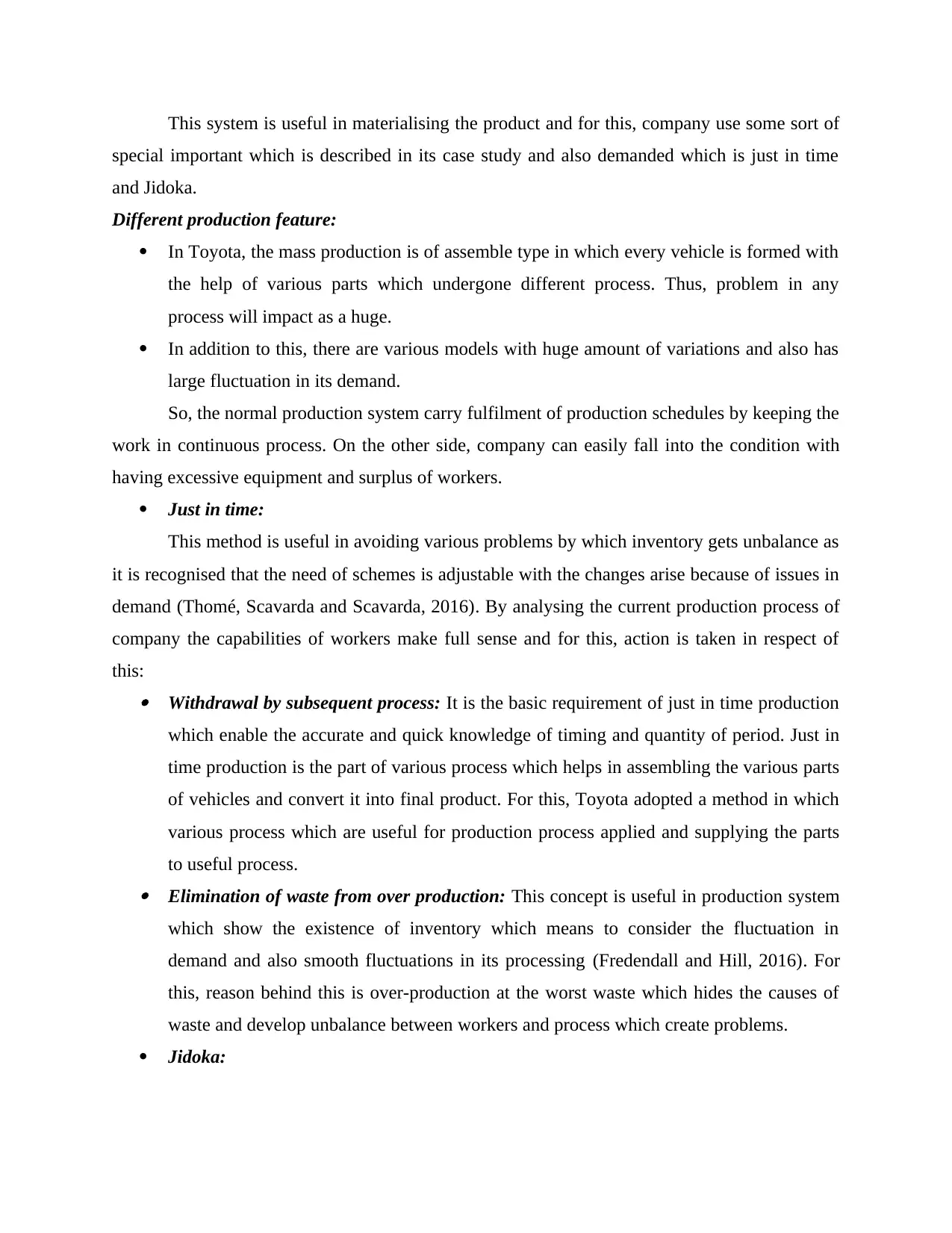
This system is useful in materialising the product and for this, company use some sort of
special important which is described in its case study and also demanded which is just in time
and Jidoka.
Different production feature:
In Toyota, the mass production is of assemble type in which every vehicle is formed with
the help of various parts which undergone different process. Thus, problem in any
process will impact as a huge.
In addition to this, there are various models with huge amount of variations and also has
large fluctuation in its demand.
So, the normal production system carry fulfilment of production schedules by keeping the
work in continuous process. On the other side, company can easily fall into the condition with
having excessive equipment and surplus of workers.
Just in time:
This method is useful in avoiding various problems by which inventory gets unbalance as
it is recognised that the need of schemes is adjustable with the changes arise because of issues in
demand (Thomé, Scavarda and Scavarda, 2016). By analysing the current production process of
company the capabilities of workers make full sense and for this, action is taken in respect of
this: Withdrawal by subsequent process: It is the basic requirement of just in time production
which enable the accurate and quick knowledge of timing and quantity of period. Just in
time production is the part of various process which helps in assembling the various parts
of vehicles and convert it into final product. For this, Toyota adopted a method in which
various process which are useful for production process applied and supplying the parts
to useful process. Elimination of waste from over production: This concept is useful in production system
which show the existence of inventory which means to consider the fluctuation in
demand and also smooth fluctuations in its processing (Fredendall and Hill, 2016). For
this, reason behind this is over-production at the worst waste which hides the causes of
waste and develop unbalance between workers and process which create problems.
Jidoka:
special important which is described in its case study and also demanded which is just in time
and Jidoka.
Different production feature:
In Toyota, the mass production is of assemble type in which every vehicle is formed with
the help of various parts which undergone different process. Thus, problem in any
process will impact as a huge.
In addition to this, there are various models with huge amount of variations and also has
large fluctuation in its demand.
So, the normal production system carry fulfilment of production schedules by keeping the
work in continuous process. On the other side, company can easily fall into the condition with
having excessive equipment and surplus of workers.
Just in time:
This method is useful in avoiding various problems by which inventory gets unbalance as
it is recognised that the need of schemes is adjustable with the changes arise because of issues in
demand (Thomé, Scavarda and Scavarda, 2016). By analysing the current production process of
company the capabilities of workers make full sense and for this, action is taken in respect of
this: Withdrawal by subsequent process: It is the basic requirement of just in time production
which enable the accurate and quick knowledge of timing and quantity of period. Just in
time production is the part of various process which helps in assembling the various parts
of vehicles and convert it into final product. For this, Toyota adopted a method in which
various process which are useful for production process applied and supplying the parts
to useful process. Elimination of waste from over production: This concept is useful in production system
which show the existence of inventory which means to consider the fluctuation in
demand and also smooth fluctuations in its processing (Fredendall and Hill, 2016). For
this, reason behind this is over-production at the worst waste which hides the causes of
waste and develop unbalance between workers and process which create problems.
Jidoka:
Paraphrase This Document
Need a fresh take? Get an instant paraphrase of this document with our AI Paraphraser
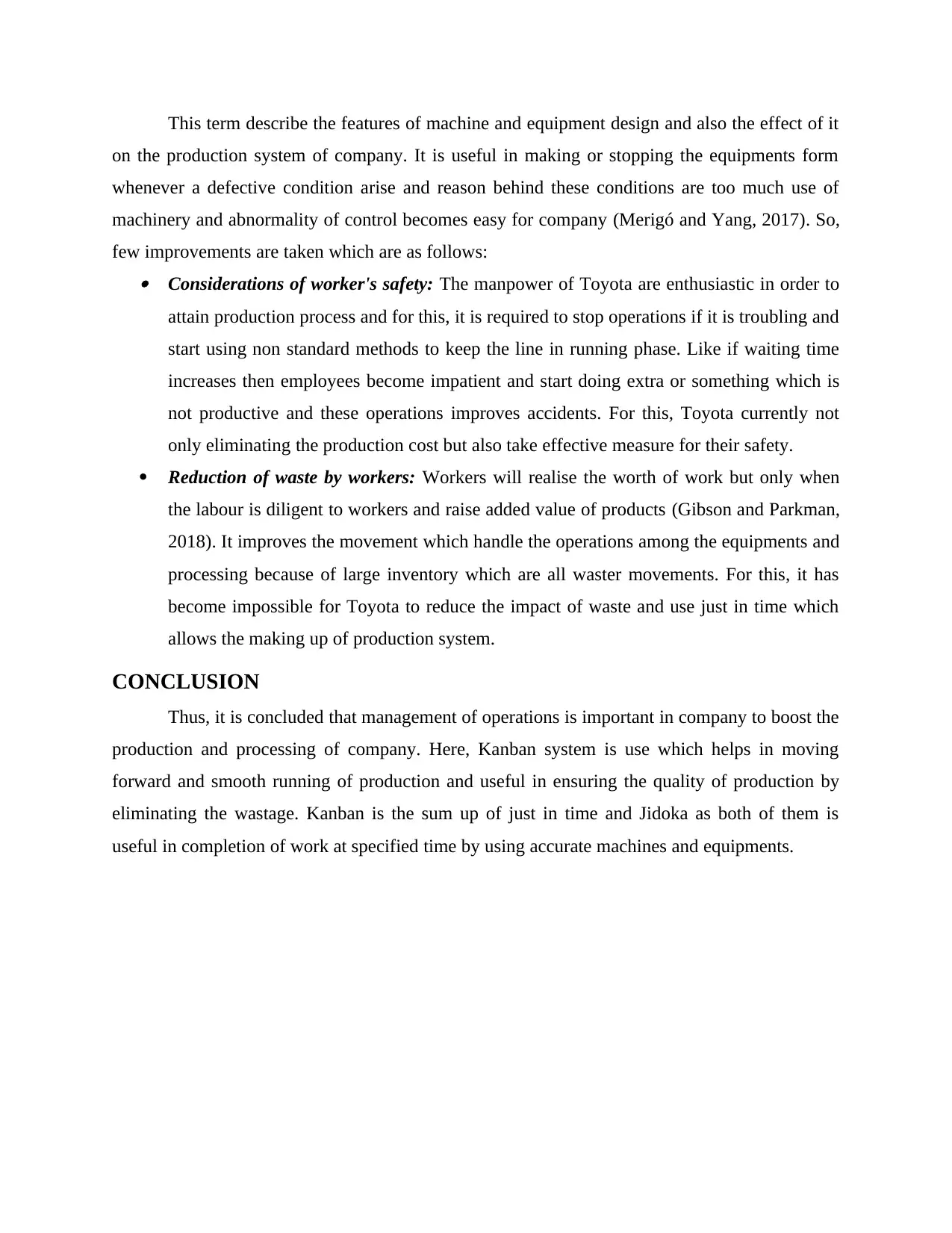
This term describe the features of machine and equipment design and also the effect of it
on the production system of company. It is useful in making or stopping the equipments form
whenever a defective condition arise and reason behind these conditions are too much use of
machinery and abnormality of control becomes easy for company (Merigó and Yang, 2017). So,
few improvements are taken which are as follows: Considerations of worker's safety: The manpower of Toyota are enthusiastic in order to
attain production process and for this, it is required to stop operations if it is troubling and
start using non standard methods to keep the line in running phase. Like if waiting time
increases then employees become impatient and start doing extra or something which is
not productive and these operations improves accidents. For this, Toyota currently not
only eliminating the production cost but also take effective measure for their safety.
Reduction of waste by workers: Workers will realise the worth of work but only when
the labour is diligent to workers and raise added value of products (Gibson and Parkman,
2018). It improves the movement which handle the operations among the equipments and
processing because of large inventory which are all waster movements. For this, it has
become impossible for Toyota to reduce the impact of waste and use just in time which
allows the making up of production system.
CONCLUSION
Thus, it is concluded that management of operations is important in company to boost the
production and processing of company. Here, Kanban system is use which helps in moving
forward and smooth running of production and useful in ensuring the quality of production by
eliminating the wastage. Kanban is the sum up of just in time and Jidoka as both of them is
useful in completion of work at specified time by using accurate machines and equipments.
on the production system of company. It is useful in making or stopping the equipments form
whenever a defective condition arise and reason behind these conditions are too much use of
machinery and abnormality of control becomes easy for company (Merigó and Yang, 2017). So,
few improvements are taken which are as follows: Considerations of worker's safety: The manpower of Toyota are enthusiastic in order to
attain production process and for this, it is required to stop operations if it is troubling and
start using non standard methods to keep the line in running phase. Like if waiting time
increases then employees become impatient and start doing extra or something which is
not productive and these operations improves accidents. For this, Toyota currently not
only eliminating the production cost but also take effective measure for their safety.
Reduction of waste by workers: Workers will realise the worth of work but only when
the labour is diligent to workers and raise added value of products (Gibson and Parkman,
2018). It improves the movement which handle the operations among the equipments and
processing because of large inventory which are all waster movements. For this, it has
become impossible for Toyota to reduce the impact of waste and use just in time which
allows the making up of production system.
CONCLUSION
Thus, it is concluded that management of operations is important in company to boost the
production and processing of company. Here, Kanban system is use which helps in moving
forward and smooth running of production and useful in ensuring the quality of production by
eliminating the wastage. Kanban is the sum up of just in time and Jidoka as both of them is
useful in completion of work at specified time by using accurate machines and equipments.
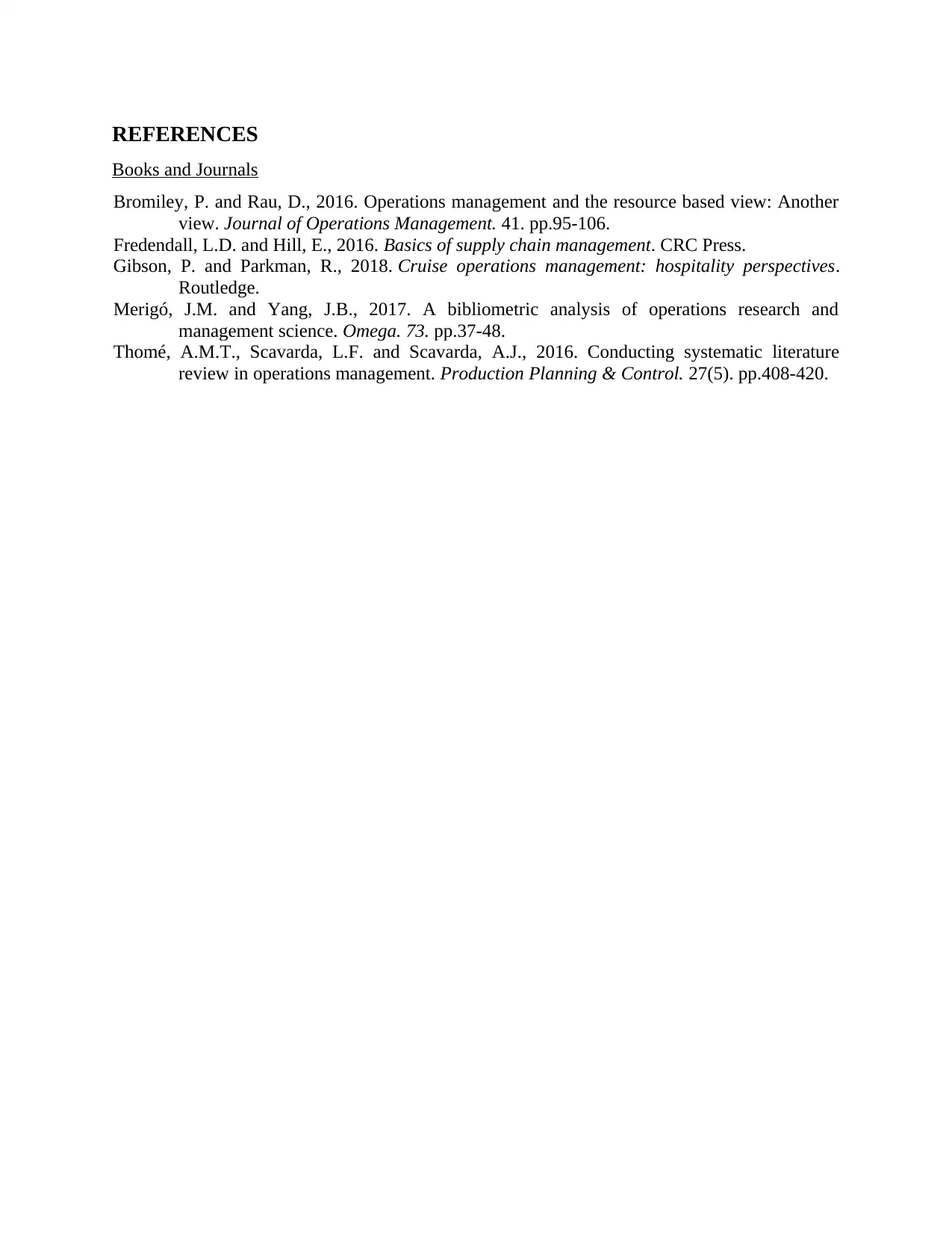
REFERENCES
Books and Journals
Bromiley, P. and Rau, D., 2016. Operations management and the resource based view: Another
view. Journal of Operations Management. 41. pp.95-106.
Fredendall, L.D. and Hill, E., 2016. Basics of supply chain management. CRC Press.
Gibson, P. and Parkman, R., 2018. Cruise operations management: hospitality perspectives.
Routledge.
Merigó, J.M. and Yang, J.B., 2017. A bibliometric analysis of operations research and
management science. Omega. 73. pp.37-48.
Thomé, A.M.T., Scavarda, L.F. and Scavarda, A.J., 2016. Conducting systematic literature
review in operations management. Production Planning & Control. 27(5). pp.408-420.
Books and Journals
Bromiley, P. and Rau, D., 2016. Operations management and the resource based view: Another
view. Journal of Operations Management. 41. pp.95-106.
Fredendall, L.D. and Hill, E., 2016. Basics of supply chain management. CRC Press.
Gibson, P. and Parkman, R., 2018. Cruise operations management: hospitality perspectives.
Routledge.
Merigó, J.M. and Yang, J.B., 2017. A bibliometric analysis of operations research and
management science. Omega. 73. pp.37-48.
Thomé, A.M.T., Scavarda, L.F. and Scavarda, A.J., 2016. Conducting systematic literature
review in operations management. Production Planning & Control. 27(5). pp.408-420.
⊘ This is a preview!⊘
Do you want full access?
Subscribe today to unlock all pages.

Trusted by 1+ million students worldwide
1 out of 6
Related Documents
Your All-in-One AI-Powered Toolkit for Academic Success.
+13062052269
info@desklib.com
Available 24*7 on WhatsApp / Email
![[object Object]](/_next/static/media/star-bottom.7253800d.svg)
Unlock your academic potential
Copyright © 2020–2025 A2Z Services. All Rights Reserved. Developed and managed by ZUCOL.





